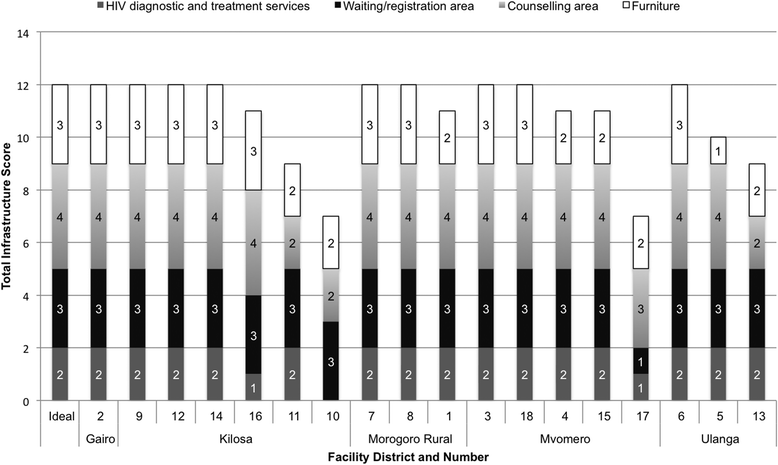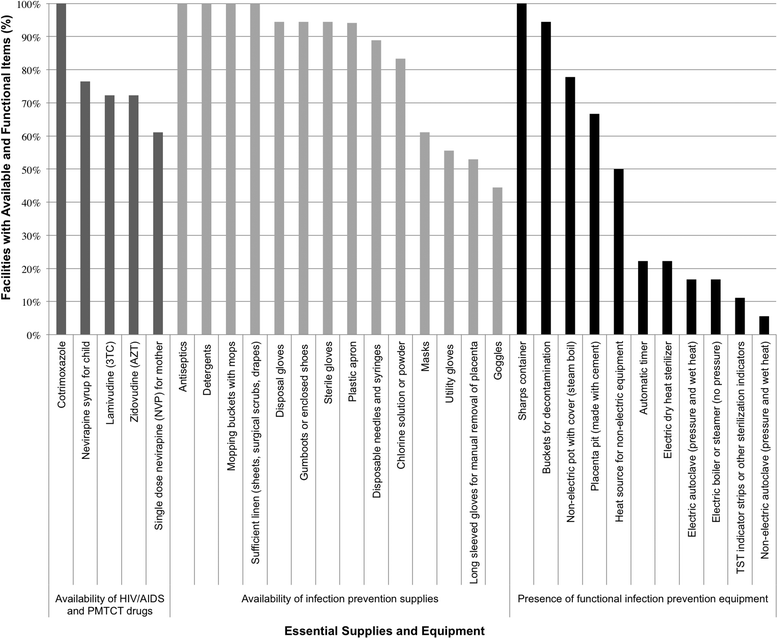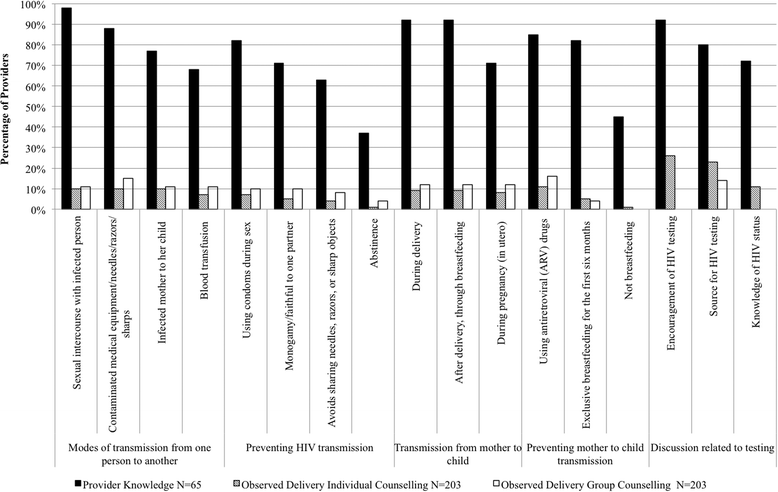Supply-side dimensions and dynamics of integrating HIV testing and counselling into routine antenatal care: a facility assessment from Morogoro Region, Tanzania
- PMID: 26433718
- PMCID: PMC4592747
- DOI: 10.1186/s12913-015-1111-x
Supply-side dimensions and dynamics of integrating HIV testing and counselling into routine antenatal care: a facility assessment from Morogoro Region, Tanzania
Abstract
Background: Integration of HIV into RMNCH (reproductive, maternal, newborn and child health) services is an important process addressing the disproportionate burden of HIV among mothers and children in sub-Saharan Africa. We assess the structural inputs and processes of care that support HIV testing and counselling in routine antenatal care to understand supply-side dynamics critical to scaling up further integration of HIV into RMNCH services prior to recent changes in HIV policy in Tanzania.
Methods: This study, as a part of a maternal and newborn health program evaluation in Morogoro Region, Tanzania, drew from an assessment of health centers with 18 facility checklists, 65 quantitative and 57 qualitative provider interviews, and 203 antenatal care observations. Descriptive analyses were performed with quantitative data using Stata 12.0, and qualitative data were analyzed thematically with data managed by Atlas.ti.
Results: Limitations in structural inputs, such as infrastructure, supplies, and staffing, constrain the potential for integration of HIV testing and counselling into routine antenatal care services. While assessment of infrastructure, including waiting areas, appeared adequate, long queues and small rooms made private and confidential HIV testing and counselling difficult for individual women. Unreliable stocks of HIV test kits, essential medicines, and infection prevention equipment also had implications for provider-patient relationships, with reported decreases in women's care seeking at health centers. In addition, low staffing levels were reported to increase workloads and lower motivation for health workers. Despite adequate knowledge of counselling messages, antenatal counselling sessions were brief with incomplete messages conveyed to pregnant women. In addition, coping mechanisms, such as scheduling of clinical activities on different days, limited service availability.
Conclusion: Antenatal care is a strategic entry point for the delivery of critical tests and counselling messages and the framing of patient-provider relations, which together underpin care seeking for the remaining continuum of care. Supply-side deficiencies in structural inputs and processes of delivering HIV testing and counselling during antenatal care indicate critical shortcomings in the quality of care provided. These must be addressed if integrating HIV testing and counselling into antenatal care is to result in improved maternal and newborn health outcomes.
Figures



Similar articles
-
Program synergies and social relations: implications of integrating HIV testing and counselling into maternal health care on care seeking.BMC Public Health. 2015 Jan 21;15:24. doi: 10.1186/s12889-014-1336-3. BMC Public Health. 2015. PMID: 25603914 Free PMC article.
-
Program assessment of efforts to improve the quality of postpartum counselling in health centers in Morogoro region, Tanzania.BMC Pregnancy Childbirth. 2018 Jul 4;18(1):282. doi: 10.1186/s12884-018-1906-y. BMC Pregnancy Childbirth. 2018. PMID: 29973185 Free PMC article.
-
Pregnant women's experiences of routine counselling and testing for HIV in Eastern Uganda: a qualitative study.BMC Health Serv Res. 2013 May 24;13:189. doi: 10.1186/1472-6963-13-189. BMC Health Serv Res. 2013. PMID: 23705793 Free PMC article.
-
Access to voluntary counseling and testing for HIV in developing countries.Ann N Y Acad Sci. 2000 Nov;918:57-63. doi: 10.1111/j.1749-6632.2000.tb05474.x. Ann N Y Acad Sci. 2000. PMID: 11131735 Review.
-
HIV counselling for women of reproductive age.Baillieres Clin Obstet Gynaecol. 1992 Mar;6(1):53-68. doi: 10.1016/s0950-3552(05)80117-8. Baillieres Clin Obstet Gynaecol. 1992. PMID: 1633660 Review.
Cited by
-
Challenges and barriers to HIV service uptake and delivery along the HIV care cascade in Cameroon.Pan Afr Med J. 2020 May 27;36:37. doi: 10.11604/pamj.2020.36.37.19046. eCollection 2020. Pan Afr Med J. 2020. PMID: 32774613 Free PMC article.
-
The Shinyanga Patient: A Patient's Journey through HIV Treatment Cascade in Rural Tanzania.Int J Environ Res Public Health. 2021 Aug 9;18(16):8418. doi: 10.3390/ijerph18168418. Int J Environ Res Public Health. 2021. PMID: 34444166 Free PMC article.
-
The influence of quality and respectful care on the uptake of skilled birth attendance in Tanzania.BMC Pregnancy Childbirth. 2020 Nov 11;20(1):681. doi: 10.1186/s12884-020-03278-z. BMC Pregnancy Childbirth. 2020. PMID: 33176709 Free PMC article. Review.
-
Healthcare workers' perceptions and experiences of primary healthcare integration: a scoping review of qualitative evidence.Cochrane Database Syst Rev. 2023 Jul 11;7(7):CD013603. doi: 10.1002/14651858.CD013603.pub2. Cochrane Database Syst Rev. 2023. Update in: Cochrane Database Syst Rev. 2023 Jul 19;7:CD013603. doi: 10.1002/14651858.CD013603.pub3. PMID: 37434293 Free PMC article. Updated.
-
Experiences in implementation and publication of operations research interventions: gaps and a way forward.J Int AIDS Soc. 2016 Jul 20;19(5 Suppl 4):20842. doi: 10.7448/IAS.19.5.20842. eCollection 2016. J Int AIDS Soc. 2016. PMID: 27443272 Free PMC article.
References
-
- Joint United Nations Programme on HIV/AIDS. Together we will end AIDS. Geneva, Switzerland; 2012.
-
- World Health Organization, United Nations Children’s Fund, United Nations Population Fund, The World Bank. Trends in maternal mortality: 1990 to 2010. Geneva, Switzerland; 2012.
-
- World Health Organization. Technical consultation on the integration of HIV interventions into maternal, newborn, and child health services. Geneva, Switzerland; 2006.
-
- Tudor Car L, van-Velthoven MH, Brusamento S, Elmoniry H, Car J, Majeed A, et al. Integrating prevention of mother-to-child HIV transmission (PMTCT) programmes with other health services for preventing HIV infection and improving HIV outcomes in developing countries. Cochrane Database Syst Rev. 2011;6. - PubMed
Publication types
MeSH terms
LinkOut - more resources
Full Text Sources
Other Literature Sources
Medical

